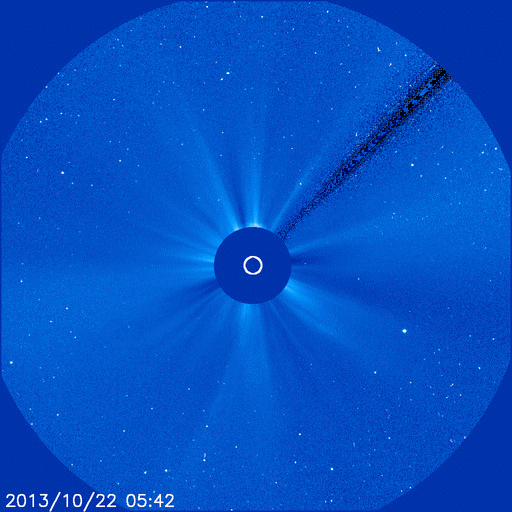What's in the sky tonight?
October 23, 2013
- Fast-growing sunspot AR1875 has developed a 'beta-gamma-delta' magnetic field that harbors energy strong explosions. NOAA forecasters estimate a 30% chance of M-class solar flares and a 5% chance of X-flares on Oct. 23rd.
-During the early hours of Oct. 22nd, a long filament of magnetism erupted on the sun. The explosion hurled a lopsided CME into space, and a new analysis suggests it could be Earth-directed. The eruption occured squarely on the Earthside of the sun, but the CME is not squarely Earth-directed. The bulk of the ejecta will fly north of the sun-Earth line. Nevertheless, the CME is expected to deliver a glancing blow to Earth's magnetic field on Oct. 24-25. It might even merge with a pair of minor CMEs traveling ahead of it. If so, the combined impact would be more likely to spark a geomagnetic storm. High-latitude sky watchers should be alert for auroras in the nights ahead.
-Every night, a network of NASA all-sky cameras scans the skies above the United States for meteoritic fireballs [brighter than Venus or magnitude -4]. Automated software maintained by NASA's Meteoroid Environment Office calculates their orbits, velocity, penetration depth in Earth's atmosphere and many other characteristics. Daily results are presented on Spaceweather.com. On Oct. 22, 2013, the network reported 38 fireballs. In this diagram of the inner solar system, all of the fireball orbits intersect at a single point - Earth. The orbits are color-coded by velocity, from slow (red) to fast (blue).

 Astro Picture of the Day:
October 23, 2013
Source:
Astro Picture of the Day:
October 23, 2013
Source:
Sixteen years ago, Comet Hale-Bopp rounded the Sun and offered a dazzling spectacle in planet Earth's night. This stunning view, recorded shortly after the comet's 1997 perihelion passage, features the memorable tails of Hale-Bopp - a whitish dust tail and blue ion tail. Here, the ion tail extends well over ten degrees across the northern sky, fading near the double star clusters in Perseus, while the head of the comet lies near Almach, a bright star in the constellation Andromeda. Do you remember Hale-Bopp? The photographer's sons do, pictured in the foreground at ages 12 and 15. In all, Hale-Bopp was reported as visible to the naked eye from roughly late May 1996 through September 1997. Currently, sky enthusiasts await Comet ISON's continued brightening in the coming weeks, unsure how interesting its first journey to the inner Solar System will be.